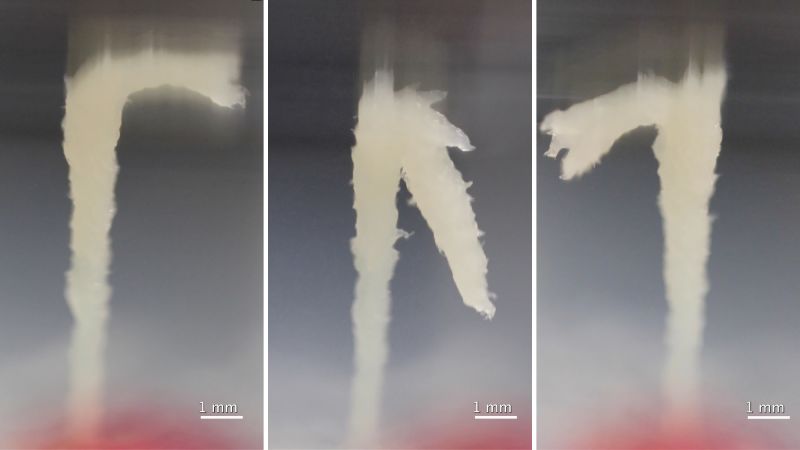- Get link
- X
- Other Apps
- Get link
- X
- Other Apps

Living Skyscrapers: Tiny Worms Build Towering Structures, Scientists Discover
Nature never ceases to amaze, and sometimes the most incredible discoveries are right under our feet. Scientists have recently uncovered the fascinating behavior of nematodes, microscopic worms, that assemble into impressive tower-like structures. This groundbreaking research sheds light on the social behavior of these tiny creatures and raises intriguing questions about their evolutionary purpose.
Nematodes: The Unlikely Architects
These miniature architects, known as nematodes, are ubiquitous, dwelling in soils across the globe. Recently, researchers in Germany made a remarkable observation: nematodes exhibiting sophisticated building techniques in their natural habitat. After meticulous observation of decaying pears and apples in local orchards, researchers from the Max Planck Institute of Animal Behavior and the University of Konstanz witnessed hundreds of these 1-millimeter-long (0.04-inch) worms clambering over one another to construct structures up to 10 times their individual size.
To delve deeper into the physics of these slimy towers, the research team brought samples of Caenorhabditis elegans, a type of nematode, into the lab for detailed analysis. The scientists were astounded to find that these worms could assemble into towers within a matter of hours, with some worms extending exploratory "arms" to sense the surrounding environment and adjust the structure accordingly. But what drives this behavior?
The study's findings, published in the journal Current Biology, demonstrate that even the smallest animals can spark significant questions about the evolutionary purpose of social behaviors.
Key Findings at a Glance:
- Nematodes form towers that can reach up to 10 times their individual size.
- These structures are assembled rapidly, sometimes within hours.
- The towers exhibit coordinated movement, acting almost as a "superorganism."
Why Build a Tower? The Evolutionary Advantage
The study team investigated the nematodes' motivation by observing their reactions to various stimuli, such as being poked, prodded, and approached by flies, all while in tower formation.
Daniela Perez, the study's first author and a postdoctoral researcher at the Max Planck Institute of Animal Behavior, stated, "We saw that they are very reactive to the presence of a stimulus. They sense it, and then the tower goes towards this stimulus, attaching itself to our metal pick or a fly buzzing around."
This coordinated response suggests that the nematodes may be joining forces to hitch a ride on larger animals, such as insects, that can transport them to new food sources. Consider this:
- A 1-millimeter worm cannot easily crawl 2 meters (6.6 feet) to the next fruit.
- Traveling alone increases the risk of death from predators or environmental factors.
- Arriving in a group may enhance their reproductive success in a new area.
Additionally, the tower structures may serve as a mode of transport themselves, with worms creating bridges across gaps to move from one surface to another, Perez noted.
Unanswered Questions and Future Research
While this discovery is truly remarkable, it also opens the door to many more questions. The researchers are now keen to understand whether this tower formation is a cooperative or competitive behavior. Are the worms helping each other, or is it more of a free-for-all scramble?
Serena Ding, a senior study author and a Max Planck research group leader of genes and behavior, suggests that studying the behaviors of other self-assembling creatures, like ants, could provide valuable insights into the social norms of nematodes.
Like ants, nematodes didn't seem to show any clear role differentiation or hierarchy within the tower structures. But since the lab-grown worms were essentially clones, it's unclear whether role differentiation happens more often in nature, where nematode populations might have more genetic differences.
Another crucial question is how nematodes communicate, if at all. Unlike ants, which use pheromone trails, or honeybees, which rely on dance routines, the communication methods of nematodes remain a mystery.
Implications for Robotics and Beyond
The study of cooperative animal behaviors has garnered significant interest within the robotics community. It's conceivable that insights into the complex sociality of creatures like nematodes could eventually inform the way technology, such as computer servers or drone systems, communicates.
This discovery not only expands our understanding of the natural world but also highlights the potential for bio-inspired innovations. As Orit Peleg, an associate professor of computer science at the University of Colorado Boulder's BioFrontiers Institute, aptly puts it, "It's both establishing the ecological function of creating a tower, and it really opens up the door to do more controlled experimentation to try to understand the perceptual world of these organisms, and how they communicate within a large group."
The world of microscopic worms is full of surprises, and this study is a testament to the endless wonders that nature holds. By continuing to explore the behaviors of these tiny creatures, we can gain valuable insights into the complexities of social cooperation and the ingenuity of life itself.
Tags: Science newsletter, CNN, Wonder Theory, Universe, Scientific discoveries, Microscopic worms, Nematodes, Max Planck Institute, Animal Behavior, Rotten fruit
Source: https://edition.cnn.com/2025/06/05/science/nematode-stacking-worms-living-towers
Animal behavior
CNN
Max Planck Institute
Microscopic worms
Nematodes
Rotten fruit
Science newsletter
Scientific discoveries
Universe
Wonder Theory
- Get link
- X
- Other Apps
Comments
Post a Comment